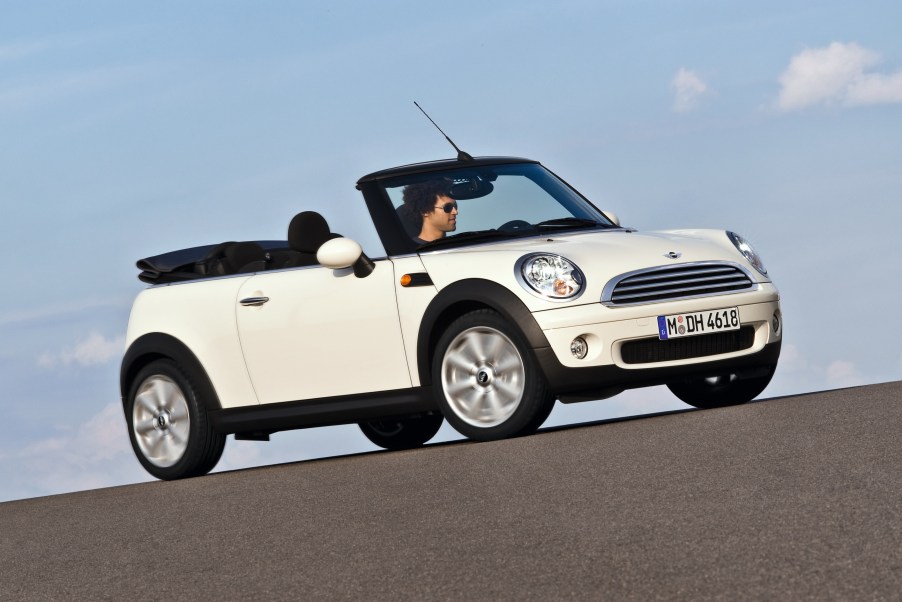
Is a Used 2009-2015 R57 Mini Cooper Convertible Reliable?
Used 2009-2015 R57 Mini Cooper Convertible reliability article highlights:
- ‘R57’ refers to the Convertible version of the second-gen modern Mini Cooper, the ‘R56’
- In addition to the R56 hatchback’s problems, used R57 Convertibles are also prone to more interior rattles, rock chips, and age-related soft top issues
- A properly-maintained R57 Mini Cooper Convertible can be reliable, but the 2013-2015 ones are usually the most reliable
Soaking up some sun in a Mini Cooper Convertible doesn’t have to burn you financially. If a new drop-top Mini is out of your budget, a used one offers the same kind of peppy performance for less cash. That’s particularly true of the R57 Mini Cooper Convertible: you can regularly find one for under $10,000. But cheap used Minis can sometimes have expensive problems. So, does that mean a secondhand R57 is a maintenance headache waiting to happen? Or can it deliver miles of stress-free sunshine?
The 2009-2015 R57 Mini Cooper Convertible let the second-gen Mini drop its top


| 2009-2015 ‘R57’ Mini Cooper Convertible | |
| Engine | 1.6-liter ‘N12/N16’ four-cylinder |
| Horsepower | 2009-2010: 118 hp (N12) 2011-2015: 121 hp (N16) |
| Torque | 114 lb-ft |
| Transmissions | Six-speed manual Six-speed automatic |
| Curb weight | 2745 lbs (2010, manual) 2822 lbs (2010, automatic) |
| 0-60 mph time | 8.9 seconds (manual) 10.2 seconds (automatic) |
Although Mini introduced the second-gen Cooper, the R56, in 2007, the Convertible didn’t arrive until 2009. Dubbed ‘R57,’ the second-gen model was also available in Cooper S form. This guide, though, focuses on the base version.
Compared to the first-gen model, the R57 Mini Cooper Convertible is slightly longer than its predecessor yet slightly lighter. That’s thanks in part to upgrades like lighter but stronger A-pillars, which also increase safety. And speaking of safety, the R57 swapped out the first-gen car’s fixed roll hoops with pop-up ones for extra rear visibility. In addition, though its cargo space is limited, the 2009-2015 Mini Convertible has more of it than the first-gen model.
Admittedly, the necessary chassis reinforcements mean the R57 weighs more than the equivalent R56. So, the 2009-2015 Mini Cooper Convertible isn’t quite as fast as the hatchback, though it’s more powerful than the first-gen model. However, thanks to convertible-specific suspension tuning, it’s just as agile in the corners as the R56 hatchback. And it comes with the same strong, responsive brakes and quick steering.
Opening and closing the R57 Mini Convertible’s cloth roof isn’t quite as quick, though. It takes 15 seconds, and you can’t close the roof if you’re going above 20 mph. But you don’t have to wait for the top to fully drop; you can open it partially like a big sunroof.
In addition to the extra horsepower and space, the R57 Mini Cooper Convertible also has more features than its predecessor. Hill-start assist, stability control, and brake-based torque vectoring all came standard in 2009, as did the ‘Openometer,’ which measures how long you drive with the roof down. Furthermore, over the years Mini added things like traction control, USB outlets, and optional heated seats. As a result, a 2009-2015 Mini Convertible still feels modern—and it still has a quirky, toggle-switch-heavy interior.
Do used R57 Mini Cooper Convertibles have a lot of problems?
Since the R57 Convertible is based on the R56 Mini Cooper, it also suffers from many of the same problems.
Firstly, over time the plastic components in its cooling system crack and fail, particularly the thermostat housing. The electric water pump can fail, too, as can the A/C evaporator. Secondly, even if they don’t leak oil from old gaskets, R57s tend to have higher-than-average oil consumption. The oil pumps in earlier N12-engined cars tend to fail at high mileages as well. And when either engine runs low on oil, its VANOS variable valve-timing system starts acting up.
Also, because both the N12 and N14 have direct fuel injection, carbon deposits often build up along their valves. Plus, ignition coil and start-stop system failure aren’t uncommon on 2009-2015 Mini Cooper Convertibles. However, these are all general second-gen Mini Cooper problem areas: the R57 also has convertible-specific issues.
For one, because its windshield is more upright, R57s are more prone to rock chips. Furthermore, since the chassis reinforcements couldn’t completely remove chassis flex, used 2009-2015 Mini Cooper Convertibles often have more interior rattles than their hatchback brethren. Depending on how rough the local roads are, the speakers can even distort and fail, WhatCar notes. And then there are the usual hassles of owning a soft-top convertible, such as old rain seals and fabric degradation.
Does that make them unreliable?


It’s worth noting that some of the worst Mini Cooper model years coincide with part of the R57 Convertible production run. In short, you want to avoid the 2009-2012 model years, which are the N12 years and the first two N16 years. Overall, though, the N16 is a solid engine if it’s maintained properly and has a more robust VANOS system.
However, it’s also worth noting that some of the R57’s problems, such as water pump failure, were addressed via recalls. In addition, those plastic cooling-system parts now have modern metal replacements. And A/C, ignition coil, and carbon buildup issues aren’t unheard-of in other high-mileage used cars. They’re fixable if you catch them in time or perform some preventative maintenance. Hence why pre-purchase inspections are so important.
Still, if you’re worried about potential mechanical headaches, a 2013-2015 Mini Cooper Convertible is your best bet. But only if it’s been serviced regularly.
Follow more updates from MotorBiscuit on our Facebook page.


